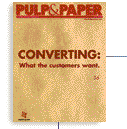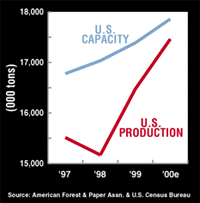INDUSTRY STRUCTURE. Recycled paperboard is primarily used to manufacture industrial and consumer packaging products. Recycled paperboard is made from 100%-recovered paper--collected from paper manufacturing and converting plants and postconsumer sources--and represents the largest single market for recovered paper in the U.S.—representing 18 million tons of wastepaper.The most important end uses for recycled paperboard are folding cartons, corrugated containers, rigid set-up boxes, composite cans, paper tubes and cores, and gypsum wallboard. The major end uses measured by paper mill production capacity are linerboard (28.8%), corrugating medium (25.4%), folding cartons (17.8%), gypsum wallboard (10%), tubes, cores, and other converting grades (18%).
PRODUCTION/CAPACITY. Total demand for recycled paperboard is growing about 6% annually, despite competition from other packaging materials. The fastest-growing segments have been coated grades used for folding cartons and 100% recycled linerboard and corrugating medium grades used for corrugated shipping containers. Production of recycled paperboard for gypsum wallboard has also been growing. At the same time, the output of uncoated chipboard grades, setup boxboards, and some miscellaneous grades has remained relatively unchanged.
Total U.S. production capacity is currently about 17.8 million tons. Recycled linerboard and corrugating medium accounted for about 90% of total new capacity additions in the past decade. Six new containerboard machines started up during 1994-95, and six more were added during 1996-97. In addition, more than 20 separate machine rebuilds and capacity expansions were completed across the U.S. at existing mills. The resurgent demand for certain recycled packaging grades, combined with the increasing need to reduce solid waste, will encourage growth in this segment of the paper industry over the next decade.
The industry is undergoing significant restructuring, as a series of mergers and asset sales have consoldiated market share and led to rationalization of capacity. In 1999, International Paper Co. sold a recycled board mill that it considered non-essential to its core business to Caraustar Industries Inc. Similarly, Fort James Corp. sold its folding carton operations and a 330,000 tpy recycled paperboard mill to ACX/Graphic Packaging Corp. In early 2000, Republic Paperboard Inc. commissioned a new paper machine with capacity to produce 220,000 tpy of gypsum wallboard paper. In addition, Caraustar and Inland Paperboard and Packaging Inc. have teamed up to convert a paper mill to produce gypsum wallboard paper.
OUTLOOK/PRICING. In general, recycled paperboard markets are highly competitive and demand for recycled paperboard in 2000-2001 period will remain strong. Total production is forecast to grow at an annual rate of 5.9% over the two-year period, according to Pulp & Paper Forecaster. The recycled linerboard grades are forecast to grow at an annual rate of 6.4%. Production of gypsum wallboard grades is projected to increase at a 5%-6% annual rate. Production of folding cartonboard will be relatively flat at about 1% growth per year.
A major concern for recycled paperboard mills is the volatility of recovered paper prices. During 1995-96, prices of recovered fiber rose to record levels and then collapsed. This pushed market prices for all recycled board grades to all-time highs before eventually falling back. During the second half of 1999, prices of OCC began climbing again and this supported the first price increase in over two years. Most mills raised prices $50/ton for coated folding carton grades.
Producers raised prices by $50/ton again during the first quarter of 2000 in reaction to rising costs for fiber, energy, chemicals, and freight. Current prices are about $590-$630/ton for coated grades and $450-$460/ton for uncoated grades.
By Noel Deking
News Editor




